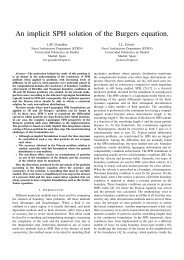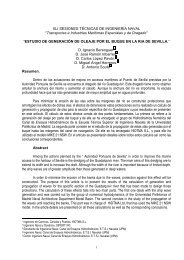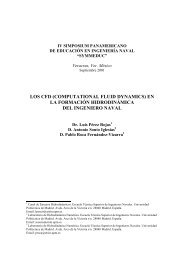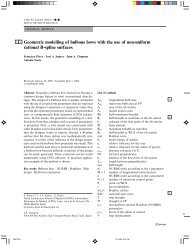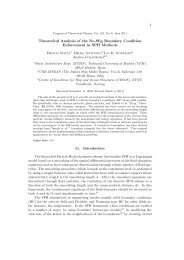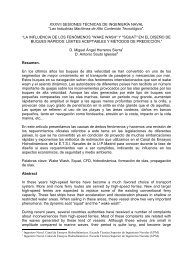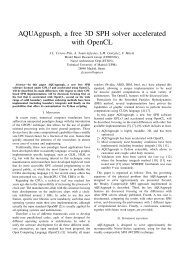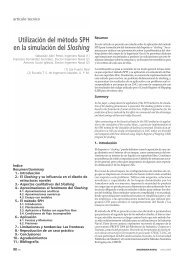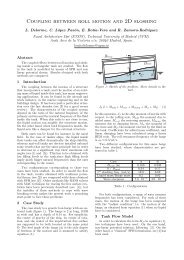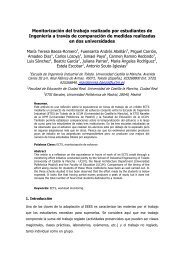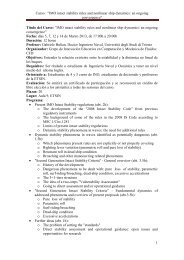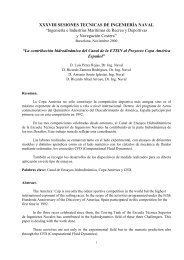imo and the safety of fishing vessels: past, present and future
imo and the safety of fishing vessels: past, present and future
imo and the safety of fishing vessels: past, present and future
Create successful ePaper yourself
Turn your PDF publications into a flip-book with our unique Google optimized e-Paper software.
Annex XXV Radar reflector Icel<strong>and</strong><br />
Annex XXVI<br />
Equipment required to comply with <strong>the</strong> Collision Icel<strong>and</strong><br />
Regulations<br />
Annex XXVII International Code <strong>of</strong> Signals Icel<strong>and</strong><br />
Annex XXVIII Distress Signals 1 Icel<strong>and</strong><br />
Annex XXIX Basic Pre-sea <strong>safety</strong> training South Africa, Rep. <strong>of</strong> Korea<br />
Annex XXX Annotated list <strong>of</strong> pertinent publications South Africa, FAO<br />
10.4.- Purpose, Scope <strong>and</strong> Highlights <strong>of</strong> <strong>the</strong> <strong>future</strong> Safety Recommendations<br />
In general terms, <strong>the</strong> Safety Recommendations follow <strong>the</strong> same structure <strong>and</strong> apply <strong>the</strong> same <strong>safety</strong><br />
principles as <strong>the</strong> Code <strong>of</strong> Safety <strong>and</strong> <strong>the</strong> Voluntary Guidelines. They follow <strong>the</strong> same chapter organization as<br />
<strong>the</strong> preceding instruments, only that <strong>the</strong>y apply to ships <strong>of</strong> lesser length.<br />
The purpose <strong>and</strong> scope <strong>of</strong> <strong>the</strong> Safety Recommendations is to provide information on <strong>the</strong> design,<br />
construction, equipment <strong>and</strong> training <strong>of</strong> <strong>the</strong> crew <strong>of</strong> small <strong>fishing</strong> <strong>vessels</strong> with a view to promoting <strong>the</strong> <strong>safety</strong> <strong>of</strong><br />
<strong>the</strong> vessel <strong>and</strong> <strong>safety</strong> <strong>and</strong> health <strong>of</strong> <strong>the</strong> crew. Unless o<strong>the</strong>rwise stated, <strong>the</strong> provisions <strong>of</strong> <strong>the</strong>se guidelines are<br />
intended to apply to new decked <strong>fishing</strong> <strong>vessels</strong> <strong>of</strong> less than 12 m in length <strong>and</strong> new undecked <strong>vessels</strong> <strong>of</strong> any<br />
length. Never<strong>the</strong>less, even where not o<strong>the</strong>rwise stated, <strong>the</strong> competent authority should as far as reasonable<br />
<strong>and</strong> practical give consideration to <strong>the</strong> application <strong>of</strong> <strong>the</strong>se provisions to existing <strong>fishing</strong> <strong>vessels</strong>.<br />
They are not intended as a substitute for national laws <strong>and</strong> regulations but may serve as a guide to<br />
those concerned with framing such national laws <strong>and</strong> regulations. Each competent authority responsible for<br />
<strong>the</strong> <strong>safety</strong> <strong>of</strong> <strong>fishing</strong> <strong>vessels</strong> should ensure that <strong>the</strong> provisions <strong>of</strong> this <strong>safety</strong> recommendation are adapted to its<br />
specific requirements, having due regard to <strong>the</strong> size <strong>and</strong> type <strong>of</strong> <strong>vessels</strong>, <strong>the</strong>ir intended service <strong>and</strong> area <strong>of</strong><br />
operation. Before doing so, competent authorities should consult with <strong>the</strong> <strong>fishing</strong> vessel owners <strong>and</strong> fishermen,<br />
<strong>and</strong> <strong>the</strong>ir re<strong>present</strong>ative organizations, <strong>and</strong> o<strong>the</strong>r relevant stakeholders such as <strong>fishing</strong> vessel designers,<br />
builders, <strong>and</strong> equipment manufacturers. When adapting <strong>the</strong> <strong>safety</strong> recommendations, <strong>the</strong> competent authority<br />
should endeavour to ensure a level <strong>of</strong> <strong>safety</strong> at least equivalent to <strong>the</strong> provision or provisions concerned.<br />
As usual for this kind <strong>of</strong> instrument, <strong>the</strong> provisions <strong>of</strong> <strong>the</strong> Recommendations do not apply to <strong>fishing</strong><br />
<strong>vessels</strong> used for sport or recreation.<br />
As we have seen, <strong>the</strong> vast majority <strong>of</strong> <strong>fishing</strong> <strong>vessels</strong> around <strong>the</strong> world are those <strong>of</strong> less than 12<br />
meters in length. In <strong>the</strong> case <strong>of</strong> developed countries, we are generally dealing with GRP boats following wellknown<br />
models with high capabilities <strong>of</strong> stability <strong>and</strong> seaworthiness. In those cases <strong>the</strong> body plan <strong>of</strong> <strong>the</strong> <strong>fishing</strong><br />
vessel is known. But this is not, in fact, <strong>the</strong> most common scenario worldwide <strong>and</strong> in most cases smaller boats<br />
are made <strong>of</strong> wood, possibly artesanal in design with no body plans or hydrostatics, with no GZ or o<strong>the</strong>r<br />
particulars.<br />
Given <strong>the</strong> fact that we are dealing with very different ship designs,i.e. those from Morocco to South<br />
Africa, from Barbados to Indonesia, it is very important that <strong>the</strong> guidelines should remain “regional” in nature.<br />
As a result <strong>the</strong>y should be determined by <strong>the</strong> different types <strong>of</strong> seas, with <strong>the</strong>ir different significant wave<br />
heights, <strong>and</strong> <strong>the</strong> different types <strong>of</strong> activity undertaken. A fisherman in B<strong>and</strong>a Aceh <strong>and</strong> his vessel will be<br />
different from those in <strong>the</strong> Red Sea in Yemen, <strong>and</strong> different again to those in Mauritania.<br />
So, <strong>the</strong> decision taken by <strong>the</strong> group was to assess different design categories <strong>of</strong> ships <strong>and</strong> different<br />
distance categories that ships could navigate up to. This is, possibly, <strong>the</strong> most outst<strong>and</strong>ing contribution <strong>of</strong> <strong>the</strong><br />
Recommendations.<br />
29



